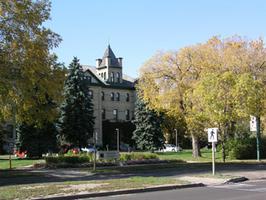
Music at Brandon University
Brandon University. Non-denominational university founded in Brandon, Man, in 1889. Originally called Brandon College, it was established by the Baptist Union of Western Canada, and was affiliated with McMaster University. It became non-denominational in 1938 when, for financial reasons, the Baptist Church withdrew its support and the college became an affiliate of the University of Manitoba. In 1967 it attained university status and became Brandon.When the Dept of Music was founded in 1906, it offered only conservatory-type instruction under the direction of Abbie Helmer Vining (1906-7). W.L. Wright, afterfour years' study in Berlin with Leopold Godowsky, took over in 1907 and remained director until 1947. During the 1920s and 1930s the department attracted students from across Canada to work with Wright, Esther Magdalene Moore, and Kathleen Moffat Fairbairn (piano), and Ruth Morgan (voice) towards the graduate and post-graduate diplomas. The Depression and World War II ended this historical high point. Under directors Peggy A. Sharpe (acting director 1947-8), and Lorne Watson (1948-81), most instruction was given to elementary and high school students from Brandon. Through the encouragement and support of successive university presidents, the music faculty and university music credit courses were expanded to make possible a music minor within a BA or B SC degree. By 1963 the college offered the first B MUS program (music education and applied) in Manitoba. The Dept of Music became the School of Music with two areas of activity: one continuing the conservatory tradition, the other leading to university degrees. Watson continued as director while Sharpe assumed the new position of supervisor of the conservatory, in which position she was again succeeded by Watson in 1981.
When Brandon attained university status, the School of Music became a member of the WBM. Later a B MUS (general) was added and, in 1980, the M MUS (music education and applied). In 1981 Watson was succeeded as director by Gordon Macpherson (1981-7, during whose tenure the position was re-named dean); in 1987 Lawrence Jones became dean.
Originally housed in Clark Hall, in 1963 the School of Music moved into a new building, officially opened by Sir Ernest MacMillan, on 28 Oct 1963. It housed a music library, electronic music studio, classrooms, rehearsal hall and studios. Increased enrolment in the 1970s necessitated the acquition of three adjacent houses. On 5 Oct 1984 Queen Elizabeth II opened the present $7 million music building, which is named after her.
The school's reputation as a centre of string pedagogy dates from Albert Pratz' appointment to the faculty in 1964 and the engagement of the Halifax Trio (Brandon University Trio) as artists-in-residence in 1966. The Wawanesa Insurance Co in 1964 established a string scholarship program, which has since been carried on through the Carl and Lyle Sanders Grant and the R.D. Bell String Scholarships. A Suzuki string program was set up in 1977 directed by Alison Ryles (B MUS Brandon 1978) who was followed in 1981 by Gerhard Ginader.
In 1990 the school had134 students and 27 teachers (19 full-time). Besides the Brandon University Trio, school ensembles include the Brandon University Orchestra, Concert Band, Chorale, Jazz Bands, and Guitar Ensemble. The Collegium Musicum, formed in 1973 by its current director, James Mendenhall, had a collection of nearly 100 replicas of early instruments in 1990. The school frequently produces an opera (or musical theatre work) directed by Sylvia Richardson.
Students pursuing a major in music education have founded an active organization known as the Brandon University Student Music Educators' Association (BUSMEA), which is, in effect, a student branch of MMEA. Annual summer schools enhance the program. In the 1960s, under the direction of Peggy A. Sharpe, recitals and workshops were given by visiting artists. In the 1980s the emphasis has been on graduate courses, including the offering of a Kodály specialist diploma.
The conservatory enrolment in 1990 was nearly 600. Music for Children classes, the Suzuki string program, and classes in the Alexander technique are offered. The Conservatory Chorale, conducted by Elizabeth Grant numbers over 70 and includes a boys' choir and two girls' choirs, one of which (The Concert Choir) won special recognition in 1989 at Toronto's MusicFest and at the 1990 conference of the Association of Canadian Choral Conductors. The conservatory has a course for gifted students. It also sponsors annual workshops for teachers. Clinicians have included Lawrence Jones, Lorne Watson, Gordon Macpherson, Sydney Young McInnis, Shirley Yip, Elizabeth Grant, and Irma Toews.
The School of Music acts as a musical focus for southwestern Manitoba. Beginning in the 1960s, it co-sponsored (with the MMEA) an annual choral/orchestral workshop in January attracting up to 300 music educators and students from Manitoba and beyond. Rehearsals of the Brandon Community Chorus and Community Orchestra take place at the school, as do most events of the Brandon Festival of the Arts. It is also the home of the annual S.C. Eckhardt-Gramatté Competition for the Performance of Canadian Music and the annual Brandon Jazz Festival. One reason for such constant activity is the excellence of the Queen Elizabeth II Music Building, which includes an advanced electronic studio, rehearsal halls for orchestras, bands and choirs, and a 200-seat hall with recording facilities and ideal acoustics. On the occasion of Watson's 40th anniversary at Brandon that hall was named in his honour.
The music school's first graduate (1966) was Jack Spalding. Honorary doctorates in music have been awarded to W.L Wright (1969), S.C. Eckhardt-Grammatté (1970), Murray Adaskin (1972), Jon Vickers (1976), and Kenneth Winters (1989).

 Share on Facebook
Share on Facebook Share on X
Share on X Share by Email
Share by Email Share on Google Classroom
Share on Google Classroom


